Space Tourism -
a new Playground for the Super-Rich?
The year 2021 opened a new area of space travel: space tourism.
Orbital hotels for tourists were an integral part of the future visions of the
1960s. After the premiere of the science fiction film "2001 - A Space
Odyssey" in 1968, both the airline Pan
Am and the Hilton hotels offered
reservations for private vacations in
orbit - of course as a marketing
campaign with no real background.
The X-Prize of 10 million dollars
awarded in 1996 for the first flight into
space with a privately developed and
reusable spaceship can be seen as the
starting point for today's tourist flights.
Scaled Composites' SpaceShipOne
spacecraft flew twice into space at the
end of 2004 and won the award.
Besides the pilot, there were no
passengers on board, but ballast for
safety reasons.
As early as 1990, a Japanese journalist had spent a few days on the
Russian Mir space station. His television-company had paid for the flight.
After that, Russia saw a source of money in such passenger flights. In
2001, the US entrepreneur Dennis Tito flew into space with a Russian
Soyuz capsule at his own expense. He was followed by some wealthy
tourists in other Soyuz. However, one cannot speak of tourist flights
here, as Russia simply rented one of three seats in the Soyuz to
interested parties from the West.
In orbit or sub-orbital?
The motivations of space tourists may be diverse - but one thing will be
present in addition to the thirst for adventure: The feeling of belonging
to the exclusive group of people, the astronauts, who have seen the
earth from very high up. This is possible with comparatively little effort in
that the passenger is briefly transported above a height that is
recognized as the boundary to space. Such parabolic flights (or sub-
orbital flights) must exceed the height of 80 kilometers or 50 miles. This
is where the mesosphere ends and the thermosphere begins,
commonly referred to as the boundary to space. Others set this limit in
100 km, but there is no binding value.
With today's providers, a passenger is only between one to four
minutes in space with up to five minutes of weightlessness. A
completely different effort is necessary for flights into earth orbit. Here
the tourist spaceship orbits the earth about every 90 minutes. The
tourists can really feel like astronauts here. Weightlessness prevails
throughout the day-long flight. While the landing after sub-orbital flights
takes place without the dangerous re-entry into the earth's atmosphere,
orbital tourists land like other professional space travelers at very high
speed by briefly becoming a ball of fire with their capsule.
The first space-tourism airlines
As the successor to the X-Prize winner, Virgin Galactic of the British
entrepreneur Richard Branson worked from 2004 on the marketing of the
improved spaceplane SpaceShipTwo. Two pilots can bring six
passengers here on a suborbital flight up to an altitude of over 80 km. A
carrier aircraft takes the spaceplane to an altitude of around 15 km for
launch. Virgin Galactic's first passenger flight took place on July 11, 2021
with four passengers on board, including Richard Branson. The landing
was done with wings like an airplane.
Just a few days later, Jeff Bezos' Blue Origin company took off on July
20, 2021 with the New Shepard rocket with four tourists, including the
company founder Bezos, on a sub-orbital flight perpendicular to an
altitude of over 100 km. On board was the 82-year-old female pilot Wally
Funk, an astronaut candidate from the Mercury program of the 1960s,
who was not allowed to fly at the time. The New Shepard rocket lands
vertically again after the flight and is reusable. The capsule separates
from the missile and lands on parachutes.
Space X's tourism flights began on September 16, 2021 with the
spaceship Inspiration4. Four passengers in a modified Dragon capsule
orbited the earth for three days at an altitude of 580 km. The spaceship
flies in automatic mode, control by the occupants is not provided.
What is the purpose of these flights?
First and foremost, these space airlines have the same goal as an
airline: make money. They are companies that offer a special service for
customers. Similar to a parachute tandem jump, a musical performance,
a trip to deep sea fishing or a trip to whale watching in Antarctica. In
addition, the companies emphasize that they want to inspire people to
deal with space travel. The occasional transport of smaller payloads for
research programs is also mentioned as a company purpose.
What the companies do not notice is that they provide a slow shift in
the technical level in space travel from flights with extremely high risk
towards a manageable transport system.
What does a space ticket cost?
One accusation quickly voiced in the media was that these flights are
only affordable for the super-rich and therefore nothing more than a new
hobby for people who already have everything. Blue Origin's sub-orbital
flight is expected to cost over $ 250,000 per person in 2021. A
SpaceShipTwo flight was set at $ 450,000 by Virgin
Galactic in 2021. Space X has not yet commented
on the costs in 2021, but is expected to be 50 to 60
million dollars per seat for a multi-day orbital flight.
Included in the price is the “astronaut training”,
which takes place within a few days at Virgin
Galactic and Blue Origin and takes a few months at
Space X. It is generally assumed that the tickets will
become much cheaper over the years and as new
providers enter the market. Air fares, which have
fallen sharply since the establishment of scheduled
air traffic, are used as an example.
Toys of the Super-Rich
For many people, including the author, a flight as a space tourist is not
affordable. But there are enough people in the world whose account
balance allows such an excursion. I do not agree with the opinion that
this behavior is immoral. With an annual income of $ 34,000, you belong
to the richest one percent of the world's population - while most of the
people on earth must manage their life on an annual income of around $
5,000, many even less than $ 1,000 a year. From this perspective, for
example, a motorcycle for joy-rides in the summer months or a new
iPhone are useless luxuries. This money could also be used differently.
The immoral rich are always the other ...
Effects of space tourism
The beginning of private flights into space has brought space travel - in a
positive and negative sense - back into the headlines. The author is of
the opinion that, in retrospect, space travel and artificial intelligence will
be considered the most important achievements of mankind in a few
thousand years. In addition to short-term benefits, such as creating
thousands of high-quality jobs and increasing the level of flight-safety,
there will also be long-term benefits from private space travel. Private
orbital flights and ultimately also private space stations will open up a
new economic area. In the long term, this will promote the colonization of
near-Earth space and later of the Moon and Mars. New production
processes in weightlessness will produce new materials and research
results.
The European space agency ESA issued a call for tenders to search
for new astronauts in 2021. For the first time, people with disabilities
were given the opportunity to apply for space flights. Space X already
implemented this on the first passenger flight in 2021. Doctor Hayley
Arceneaux beat bone cancer as a child, but had one leg amputated. She
flew the Dragon capsule with a prosthetic leg and sees herself as an
example of never giving up. In addition, she collected donations for a
children's clinic.
The future of passenger flights
The number of people who have ventured into space on commercial
flights will soon exceed that of professional astronauts. New providers
will enter the tourism business and flight prices will fall. Media interest
will cool off quickly. Sub-orbital flights will soon no longer be as attractive
as they were in the early days. With the establishment of space stations
for tourists, the high-priced flight business will focus on orbit.
One development that has so far affected every new technology will
hopefully not occur in private space travel: a flight disaster with the loss
of the crew. This occurred twice in 135 flights on the Space Shuttle. The
causes were too complex to be discussed here. In addition to
technology, the management in private companies is primarily
responsible for deciding on safety and not profit in case of doubt.
Private opinion of Uwe W. Jack

Blue Origin’s New Shepard Rocket lifts off with
four passengers.
(click to enlarge)
The hot end of New Shepard. The engine burns
oxygen and hydrogen, producing pure water.
(click to enlarge)
After the flight, New Shepard’s booster lands
near the launch site.
(click to enlarge)
After touch down of the maidenflight, Jeff Bezos (with hat) is welcomed by his wife. Former
Mercury-astronaut-candidate Wally Funk is about to leave the capsule. (click to enlarge)
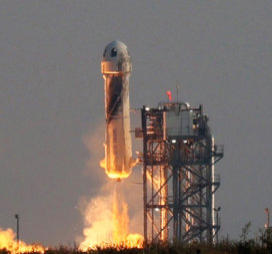
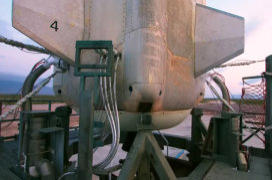
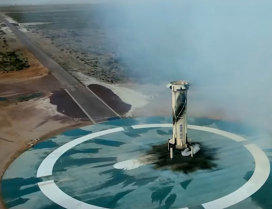
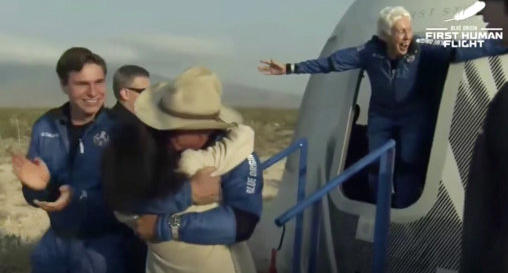
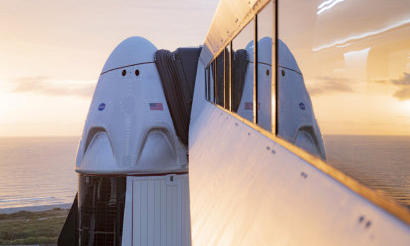
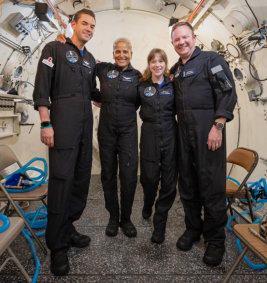
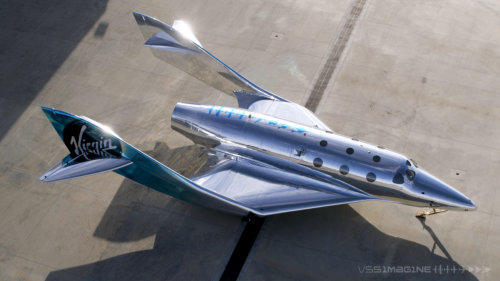
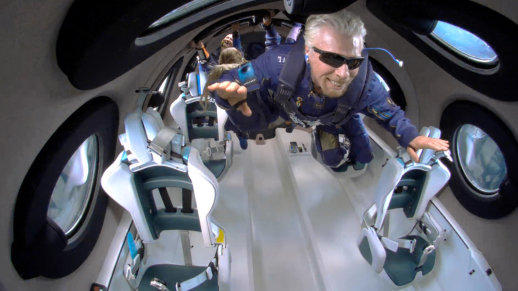
Virgin Galactic’s space plane SpaceShipTwo -
a beautiful design!
(click to enlarge)

An enthusiastic Richard Branson floates inside SpaceShipTwo in the weightless flight phase.
(click to enlarge)





The Dragon capsule of Space X awaits take
off at the coast of Florida.
(click to enlarge)


The passengers of the Dragon capsule
“inspiration4” during training. Second from right
is Hayley Arceneaux, the first disabled person
in space.
(click to enlarge)









